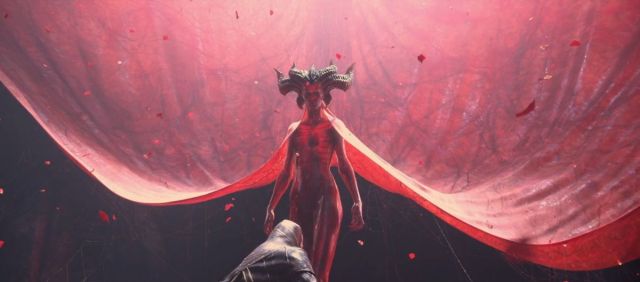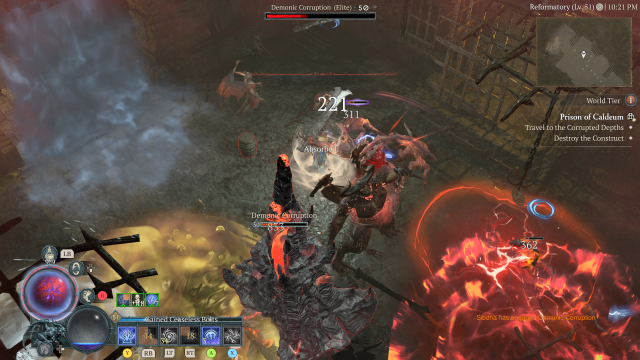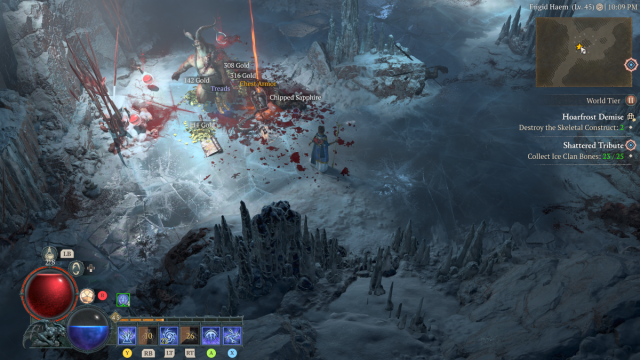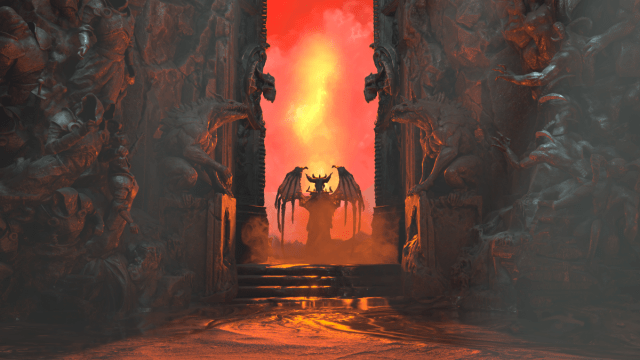Diablo IV is a game that’s been teasing us for the past few weeks, giving us little nibbles of beta bashes and server slams. But I had the immense pleasure of playing the game in full for a little less than two weeks. And in that time, I clocked around sixty hours of gameplay, completed the campaign, unlocked World Tier III, and tried every piece of post-game content. All of that’s to say, Diablo IV is an exceptional game that will grab a particular player by the throat and refuse to let go. And I mean that in the best way possible.
Diablo IV Review | Become a God Among Broken Men
Because Diablo IV is a monster of a game, there’s a lot of ground to cover. Here’s how it breaks down.
The Road to Hell is Paved with Good Intentions (and Hidden Motivations) | The Plot & Characters
Diablo’s plot has been the subject of hundreds, if not thousands, of multi hour-long YouTube videos. But for new players who are dipping their toes into the series for the first time, here’s an extremely abridged version of the events so far.
A Little Bit of Context Goes a Long Way
An endless war rages between heaven and hell. Lilith, a denizen of Hell, and Inarius, an angel of Heaven, sought to create a place free of the Eternal Conflict. And to do so, they created Sanctuary, the realm where Diablo IV takes place.
In this refuge, Lilith and Inarius create an entirely new race called the Nephalem. These beings surpassed both their Hellish mother and Heavenly father in strength. Inarius sought to weaken them, and did so, creating the enfeebled humans that populate Sanctuary today. But Lilith sought to protect the Nephalem, in the hopes they would be a force that could end the Eternal Conflict once and for all. It’s this schism that led Inarius to banish Lilith into the void.

And So Begins Diablo IV
And it’s Lilith’s return that ushers in Diablo IV. The protagonist shares an innate connection with Lilith, which allows them glimpses into Lilith’s whereabouts. And it’s this ability that might be the only thing that stops Sanctuary from totally succumbing to Lilith’s schemes.
There are six acts in Diablo IV’s campaign, and from the start you have the option of choosing which threads you want to pursue first. But all acts eventually merge as you chase Lilith across Sanctuary, always lagging one step behind.
While there’s enough intrigue in the first three acts to keep a first-time player engaged, it’s like stepping into the middle of a story. But if you persist, and I really recommend you do, the plot hits its stride as you push into Act IV. At this point, the plot crystallizes, and your character will truly take center stage, and the narrative strengths of Diablo IV’s main plot unfolds.
But that’s not to say it’s a perfect story. It’s not, and it was never meant to be. There is no happy ending in a world like Sanctuary. No timeline in which things end without bloodshed and death. And every character you encounter is fraught with their own moral failings, their vanities and obsessions, their broken spirits. But it’s through these characters Diablo’s true theme is revealed.
This is a story of finding hope in a world that has long since forgotten the meaning of the word.
“Every character you encounter is fraught with their own moral failings, their vanities and obsessions, their broken spirits. But it’s through these characters Diablo’s true theme is revealed. This is a story of finding hope in a world that has long since forgotten the meaning of the word.”
And yet, where its writing falters is in the way it handles its last moments. There is so much tension and momentum in the last acts. But the resolution doesn’t have the finality such an epic plot demands, likely because it’s making room for events that will be added to the game in the coming seasons.
It’s a tragedy, as it steals away the sense of achievement such a hard-won journey deserves.
My only other gripe comes in the form of our favorite fallen angel, Inarius. Without spoiling anything, Diablo IV was meticulous in crafting multi-faceted characters with their own set of flaws and motivations. But Inarius, in all his glorious trappings, felt flat. This was jarring in the face of Lilith’s character, which has depth unlike any other character I’ve seen in a recent game.
But no matter how well-written a story, it’s nothing without good gameplay.
A Bleak World with No Shortage of Things to Do | Gameplay
I played Diablo IV on World Tier difficulties I, II, and III to get a full perspective on how the game would feel for all levels of players. I also opted to go with a fun build instead of a meta build, to gauge how much freedom there was in build crafting.
And because there’s so much content, I’ll be dividing this section into world activities, boss battles, and a general overview of gameplay from levels 1 to 55.
Side Quests, Dungeons, and Cellars, Oh My
Combat is the lifeblood of Diablo IV, and it’s the current that runs beneath every activity. Thick, hostile mobs of vile creatures and twisted humans crowd the plains and forests that stretch between each pocket of civilization, ready and willing to let you test your latest build on them. Dungeons crawl with all types of monstrosities. Events scattered across the land will let you tackle waves of enemies for XP and rewards.
“Combat is the lifeblood of Diablo IV, and it’s the current that runs beneath every activity.”
But I had the most fun with the side quests. There’s over one hundred, and I’ll admit, I’m all about lore and world-building. A game without depth is one that won’t hold my attention for long. But I learned more about Sanctuary and its world through these side quests than I did any campaign mission, and my efforts were rewarded with XP and lots of herbs and hide. Side quests rarely dropped significant armor or weapons, but they were still a highlight of the game for me.
Dungeons offered challenging corridors full of monsters and very mild “puzzles” you’ll need to complete before reaching the final boss. Your reward upon trouncing the local big bad is an Aspect and a pile of treasure, which further strengthens your build… if you’re lucky. RNG plays a significant role in getting the loot you want.

These dungeons are procedurally generated, meaning each time you enter, you’ll get a unique map experience. And depending on your World Tier difficulty, these dungeons can be a casual stroll through rivers of blood or a tactical and cautious assault that makes the game feel like a survival horror.
I opted to only complete dungeons that offered Aspects for my class, as I found the experience repetitive. But what added a bit of heart-pounding fun was encountering a Butcher. The Butcher is a massive atrocity with hard-hitting attacks that appears as a rare random event in dungeons. And I’m not exaggerating when I say it took me fifteen minutes to whittle him down to a pile of viscera and bones. Unfortunately, the loot didn’t scale with the amount of effort it took to bring him to heel. But it was still a fun thing to encounter, and I look forward to meeting my next one.

Cellars are essentially one-room dungeons that are good for a bit of loot and XP but something I mostly ignored. By just playing the game and doing side quests, I got the same amount of benefits without subjecting myself to a loading screen.
Bullet Hell Boss Battles
You’ll encounter boss battles throughout the game, both in dungeons and in the campaign. And these moments were easily my favorite moments in the game. Unlike the mobs that choke Sanctuary’s wilds, which throw themselves at you with repetitive and telegraphed assaults, boss battles have unique combat mechanics that turn the field into a bullet hell game. Waves of fire and blood, eldritch orbs, and hellish ritual circles all need to be dodged as you peel away the boss’s defenses. And having the boss essentially explode into a pile of loot always feels good. A ten out of ten experience, easily.
A Bird’s Eye View – Gameplay from Level 1 – 55
I found as I played through my two characters (one at World Tier I, the other at World Tier II), that there were ebbs and flows in the game’s difficulty and how much fun I was having.
Diablo IV gives players of all experience levels the perfect start. You’re given access to your first ability point, which will become your primary attack. Every time you level up, you get a new point to spend in your skill tree, and these can be reset for free, giving you plenty of room to explore and figure out what builds you like best.
Level 1 – 25.
But during these early levels, enemies are made of wet tissues. Look at them too long and they’ll disintegrate. That’s true for both World Tier I and II, and it stays that way until you hit levels 22 – 25. It’s at this time you’ll get your first “growing” pains. That’s because enemies and side quests scale with you, and it’s likely you’ll start uncovering weaknesses in your skill build, armor, or weaponry. It’s no coincidence that around this level you’ll unlock gems, better potions, and Aspects, which help level the playing field.
Level 25 – 40.
I spent a significant amount of time between levels 25 and 40 just exploring the map and its cities, completing side quests, and delving into the dungeons. But once you hit level 40, things hit another rough spot.
The enemies get another buff around this time, becoming notably more difficult. I really had to analyze my armor mods, take my aspects seriously, and start grinding out resources. But because I was still leveling up at a decent rate, much of the armor I bought and altered ended up being traded for something else a few dungeons later. And because I wasn’t getting many Legendary Armor or Weapon drops, I didn’t have enough resources to keep the mods I really wanted on my equipment.
It was an awkward growing period that continued right on until level 47 – 50, when Legendary gear dropped with more regularity. This is important because you need to salvage Legendary Gear to get resources that will allow you to imprint mods on the weapons and armor pieces you really want.
Level 55+.
So, full disclosure, I could only make it to level 55 before the server closed. But it’s around this level, when you have access to three different World Tiers, that combat feels really good.
At this point, I had the mods I wanted, enough resources to ensure that I could keep them, and my multi-hit / stun / crit build really blossomed. I kept this build from level 1 to level 55, without ever resetting, and it served all the way through World Tier III. And while it didn’t always excel, particularly against meaty bosses, with the right playstyle, it was always viable.
And for me, that’s huge. If we’re going to have to re-roll characters every season, being able to play with builds outside of the meta is integral to keeping things fresh and fun.
A Little Thoughtfulness Goes A Long Way – Quality of Life Features
Quite a bit of consideration was poured into quality-of-life features in the game, which deserves a round of applause. This is demonstrated in a myriad of places, in both small and big ways.
For example, once you complete the campaign, you’ll never have to do it again. Meaning your second character can grab the extremely useful mount right off the bat. But these moments of consideration also appear in how Waypoints are distributed across the map, in the opportunity to reset your skill tree for free at early levels, and how you’re conveniently teleported after a campaign mission.
Likewise, the ability to transmog your character’s appearance and share loot between characters in the same world was a godsend. Both in allowing me to slay while slaying and in getting my second character leveled up so I could reach those post-campaign activities.
Now The Real Game Begins | Post-Campaign Activities
After surmounting all the challenges that the campaign offers, the game really opens up. Sanctuary and its myriad of waypoints are at your fingertips, and you’ve likely unlocked every skill point you can use, meaning that every build for your class is now available.
As a game that focuses heavily on its live-service aspect, Diablo 4’s post-campaign activities involve:
- Unlocking World Tiers
- Paragon Boards
- Helltide
- Nightmare Dungeons
- Whispers of the Dead
- Fields of Hatred (PvP)
As you reach higher levels, the ultimate goal is to craft the best build possible. And that’s what each of these activities helps you achieve. By unlocking World Tiers, which is possible by tackling capstone dungeons, you gain access to unique drops like Ancestral, Sacred, and Unique Items. Helltide and Whispers of the Dead allow you to get armor for particular slots. The Paragon Board allows you to boost your stats directly, with the added benefit of glyphs which give your build an extra boost.
And the Fields of Hatred? It’s on those blood-soaked sands that everything comes together, and you can test just how good your build really is. There’s even PvP-specific cosmetics for both your character and mount, which cost a pretty scarlet penny.

If you’re the type of person who finds joy in build crafting and hunting down the perfect piece of armor, you’ll find an endless array of things to do in the post-game. But if you’re more narrative-driven like me, it’s likely that this broad spectrum of activities will all bleed together. I can’t fully gauge the longevity of the game, as we’ve yet to see how Blizzard will handle seasonal content, but I remain hopeful. Not everyone likes the battle pass system, but for me, it’s a signal that Blizzard at least intends to keep the content coming.
She’s Beautiful and Mundane All at Once | Visuals
Visually, Diablo IV is a bit of a mixed bag. Sanctuary is composed of five distinct regions which seem to take inspiration from medieval Europe, Northern Europe, Scotland, Morocco, and the Mediterranean. And while that seems like it’d be a lush landscape, many of the color palettes in these regions are limited, edging towards dull colors that blend together.
And yet I can’t say that this isn’t a beautiful game. I was awed by the amount of detail that went into the smallest aspects, from the tiles in the dungeon floor to the Drudic charms wrapped around ritual rocks. There are Lovecraftian tentacles that seem to throb with an otherworldly life. Monster animations can be visually stunning and grotesque all at once.

But if you walk around Sanctuary, it’s unlikely you’ll be able to recognize a single landmark that makes the map distinct. Without a map and a pin to mark the way, I would be perpetually lost in the wilds of Sanctuary.
It is a beautiful game mired in a drab palette that shrouds its best aspects.
The Final Verdict
I’ve written a lot of words about Diablo IV, and I think that accurately reflects how much of an influence this game had over me in the short period I had to play it. Diablo IV is a game with a deeply involved combat system, a complex and well-established world, and all the hallmarks of my next gaming obsession. But it’s not a perfect game. It can occasionally feel repetitive, particularly as you get mired in the post-game activities. But it’s hard to really knock Diablo IV on that when I’ve only played the review build and haven’t been able to experience the seasonal activities that are coming down the pipeline.
But because of that, and some significant bugs, I have to give Diablo 9 out of 10. Otherwise, this is a titan of a game you should really clear your schedule for.
Diablo IV will be available on PlayStation 4, PlayStation 5, Windows, Xbox One, and Xbox Series X/S for Early Access on June 1, then available for all on June 6.


DIABLO IV
PROS:
● A sweeping, epic plot with mutli-dimensional and flawed characters.
● A dynamic and complex combat system that only gets better the deeper you go.
● A lush, fully developed world with ample secrets to uncover.
CONS:
● An unsatisfactory final act.
● The gameplay loop can feel repetitive.
A copy of this game was provided by the publisher for review. Reviewed on Xbox.





Published: May 30, 2023 12:00 pm